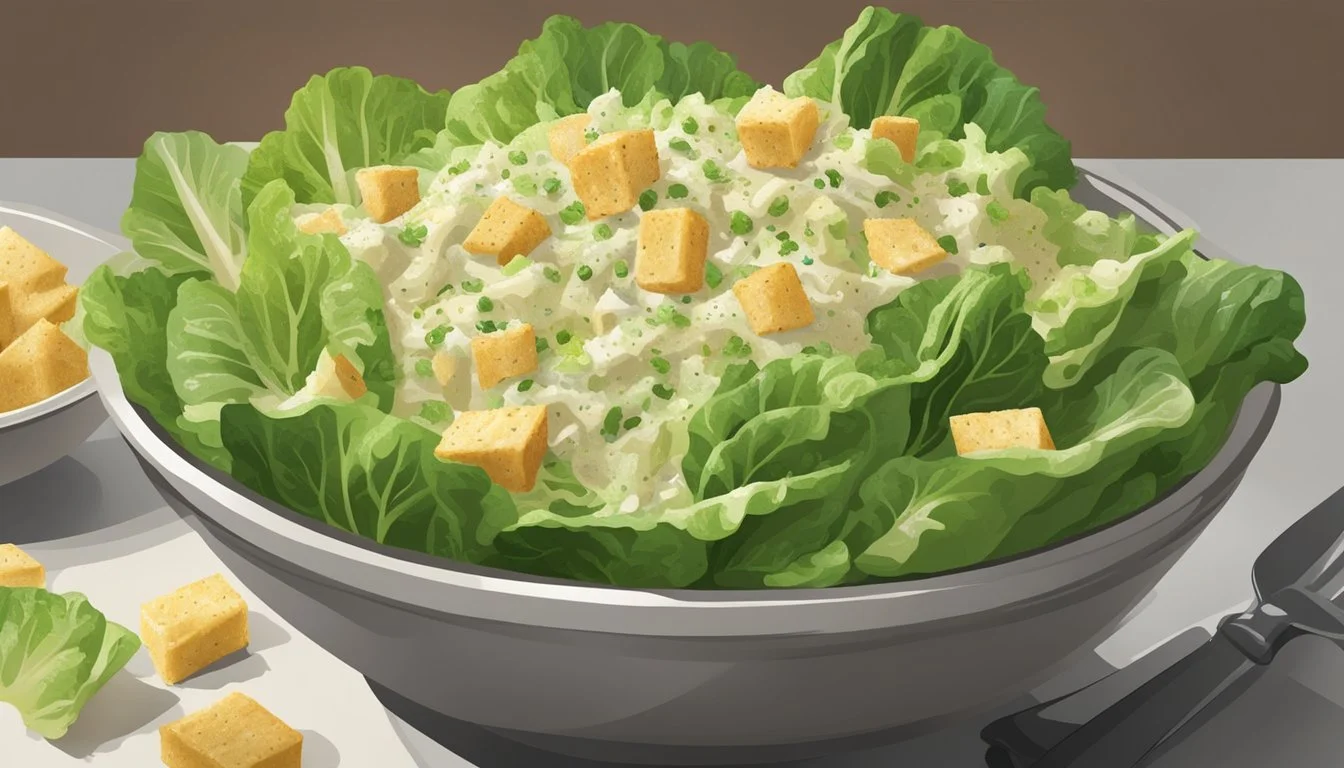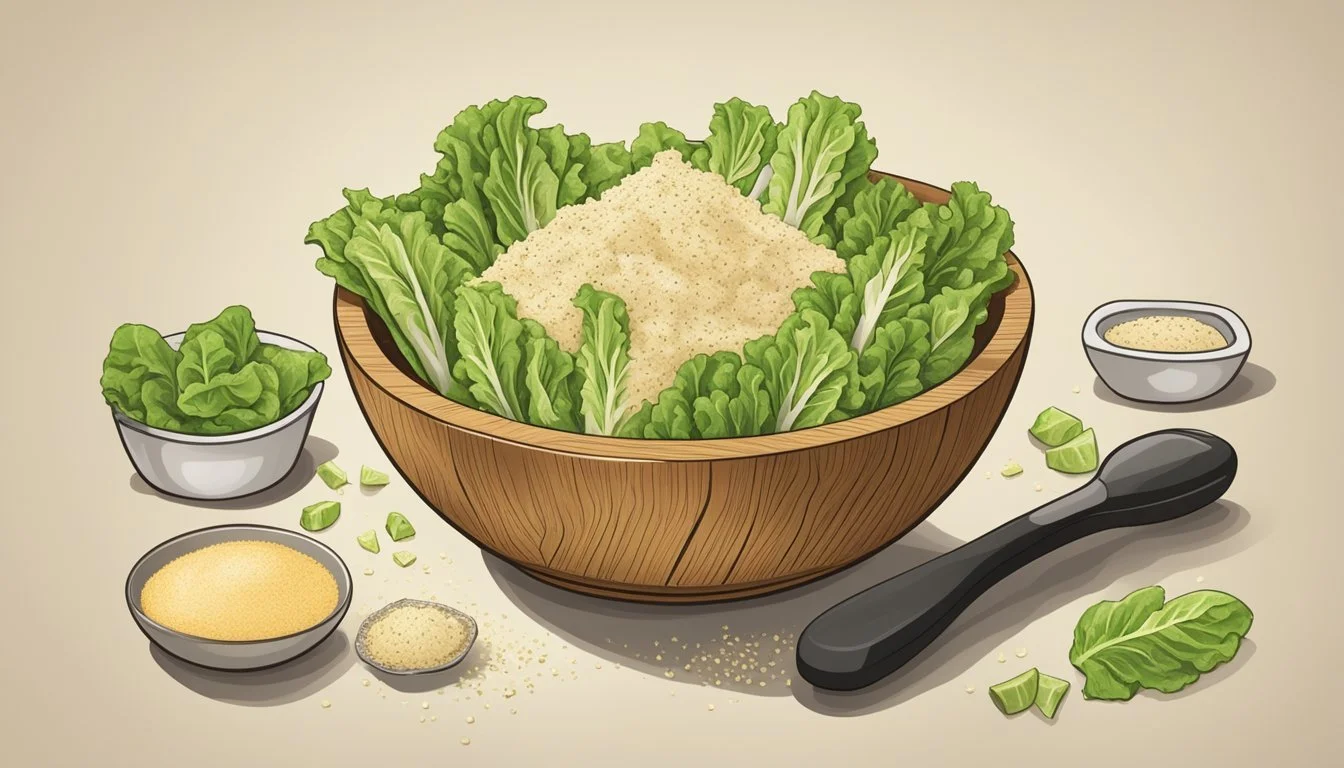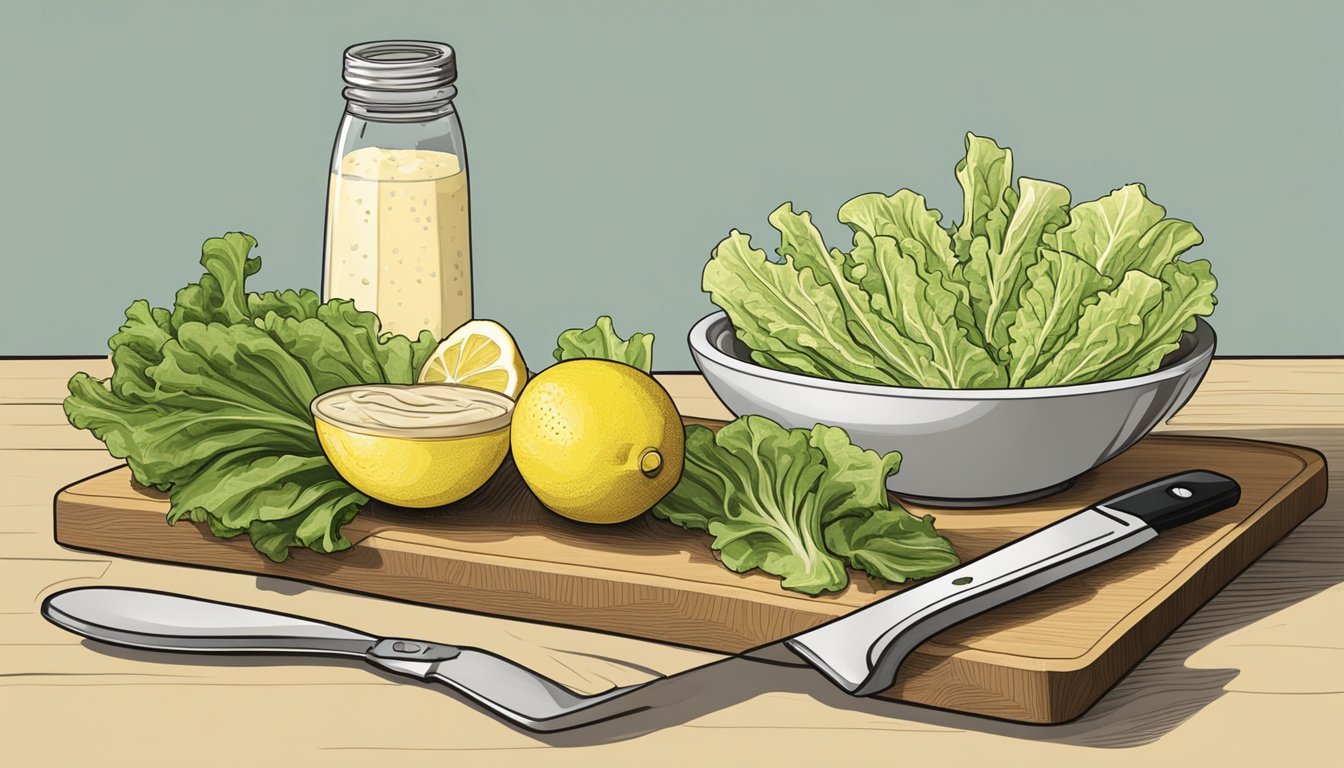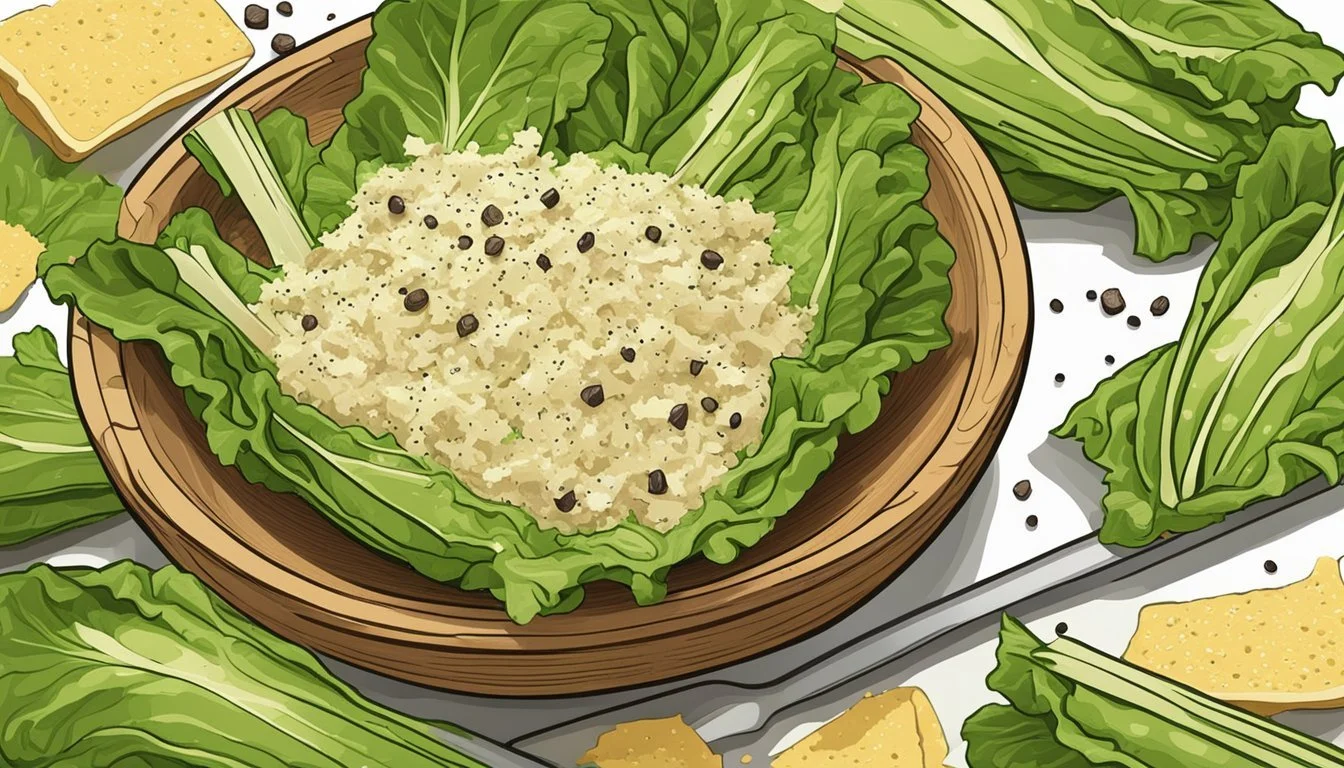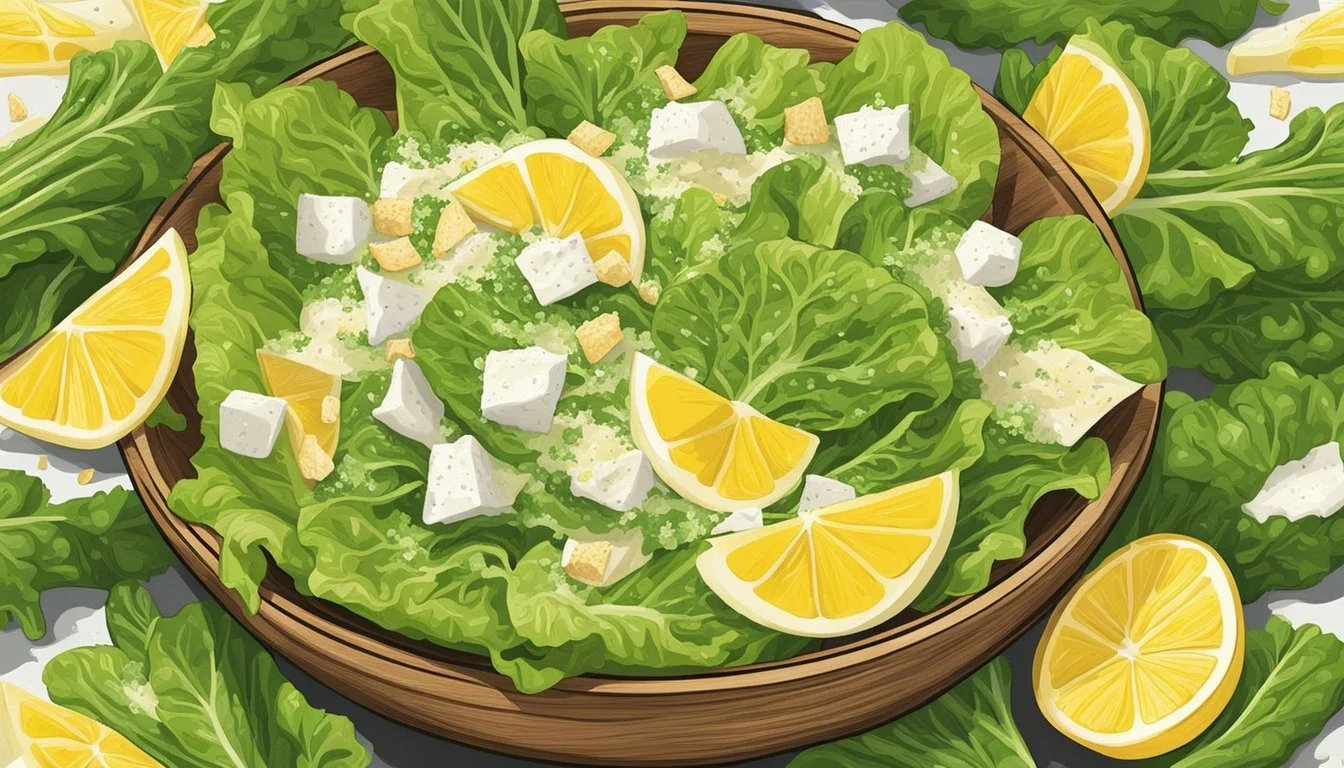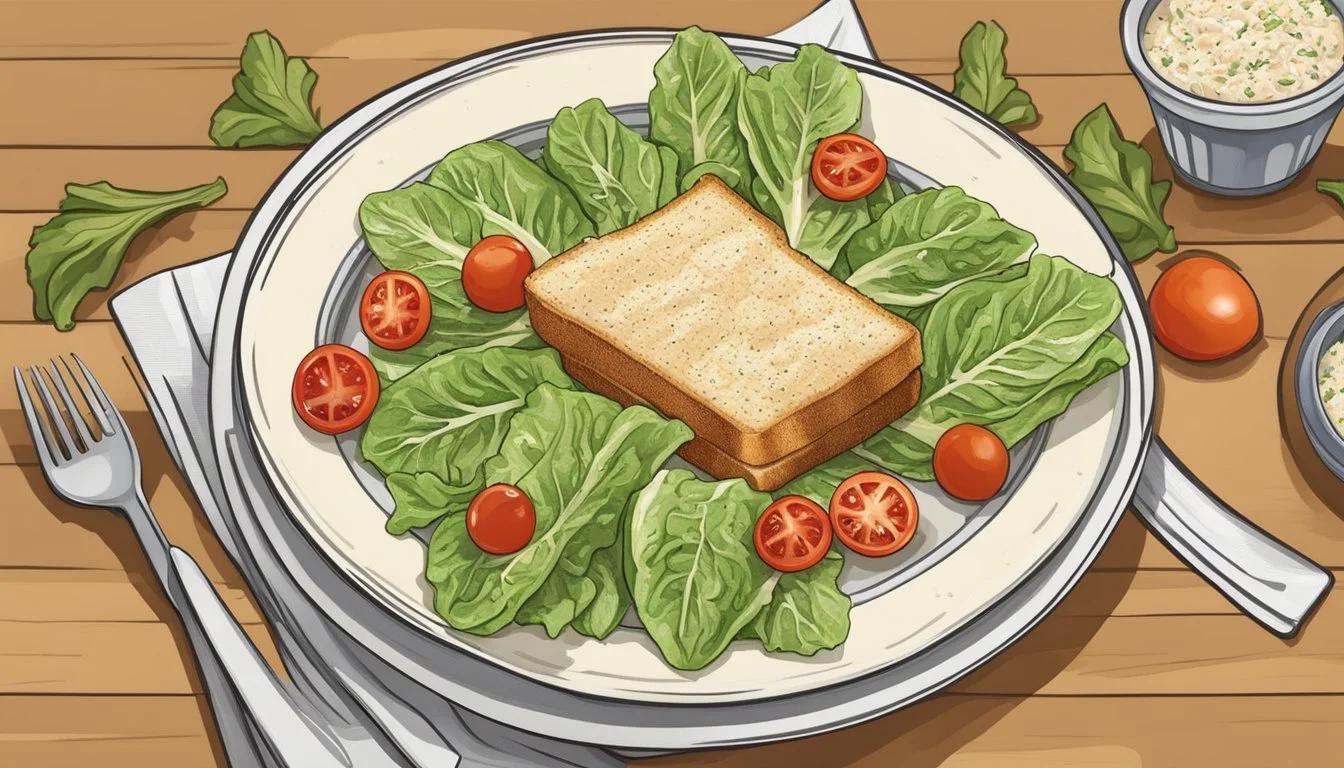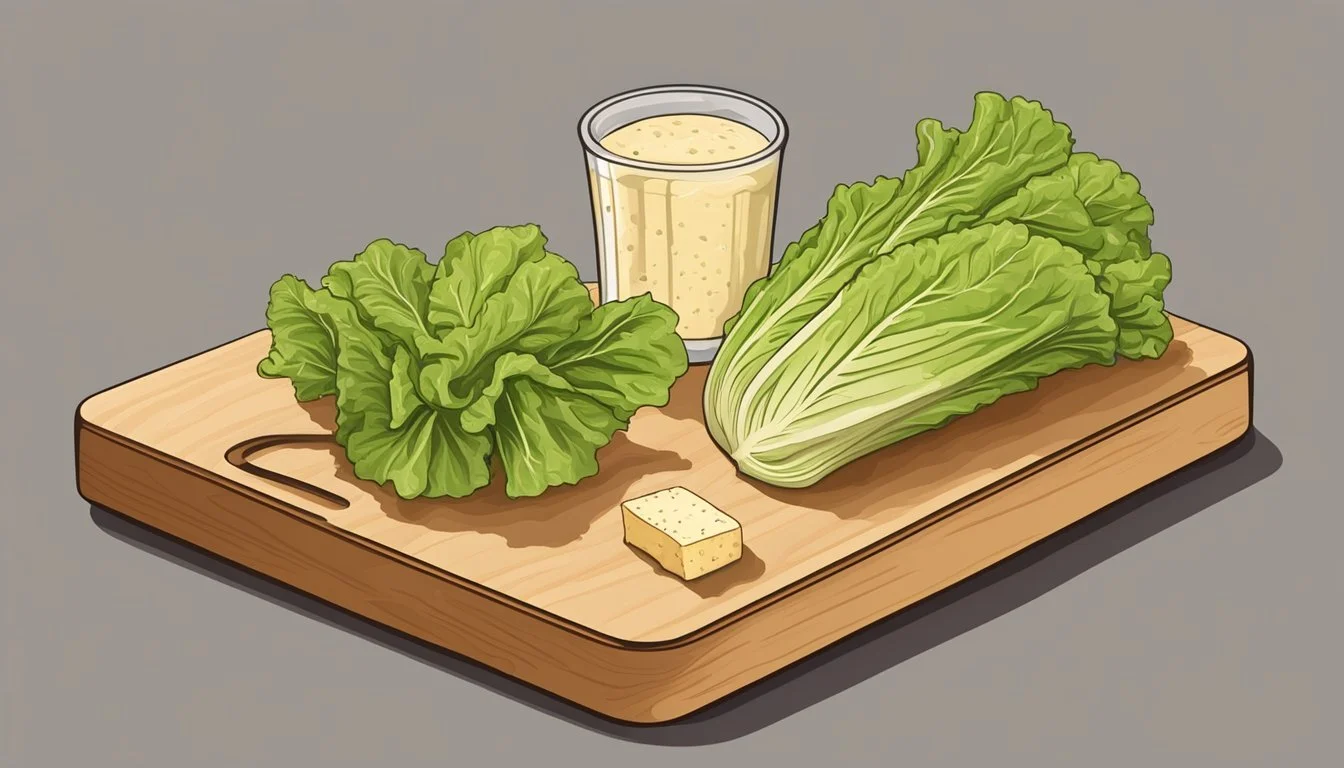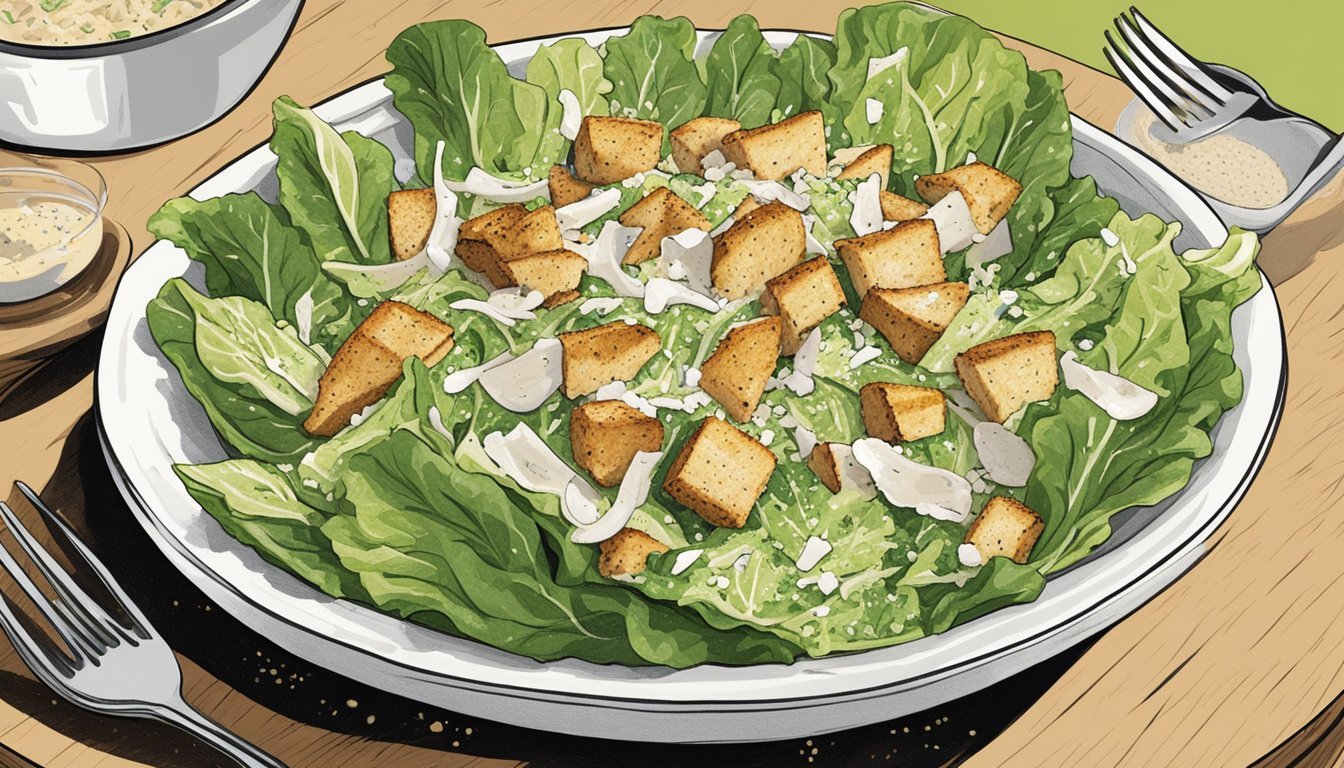How to Make a Texas-Style Caesar Salad
A Twist on the Classic
Caesar salad, a timeless classic, finds a unique twist in the Texas-style variation, blending the traditional creamy dressing with bold flavors characteristic of Texan cuisine. This fusion results in a dish that offers both the beloved elements of the original recipe and an added kick of southwestern flare. Key components of a Caesar salad include crisp romaine lettuce, a rich and tangy dressing made from ingredients such as egg yolk, Dijon mustard, garlic, Worcestershire sauce, fresh lemon juice, and anchovies, (What wine goes well with anchovies?) topped with Parmesan cheese and crunchy croutons for textural contrast.
In true Texas fashion, modifications to the Caesar dressing impart a smoky or spicy undertone, often achieved by incorporating elements like chipotle peppers, roasted jalapeños, or even a splash of barbecue sauce. The essence of the salad is preserved, but the Texas-style dressing provides a distinctive taste that captures the hearty, bold spirit of Texas culinary traditions. Alongside these changes, additional protein such as grilled chicken, steak strips, or shrimp, (What wine goes well with shrimp?) often found in Texas Roadhouse versions, can be added to elevate the salad into a substantial meal.
The art of crafting this Texas-style Caesar salad lies in balancing the rich flavors carefully, ensuring that every bite harmonizes the creamy punch of the classic Caesar with the robust, smoky notes that are quintessentially Texan. Whether served as a refreshing starter or a main course, this dish promises a delightful blend of tradition and innovation, tailored to please both Caesar salad enthusiasts and those seeking a taste of the southwest.
Origins of Caesar Salad
The Caesar Salad is a dish steeped in culinary history, originally concocted in Mexico and later popularized in the United States. Its signature Caesar dressing, anchovy-infused and tangy, has seen various regional adaptations, including a Texas-style twist.
Classic Caesar Salad
The classic Caesar Salad was reportedly created in Tijuana, Mexico, by restaurateur Caesar Cardini in the 1920s. Cardini, an Italian immigrant, capitalized on the influx of American tourists during Prohibition. Featuring romaine lettuce, Cardini's original salad was prepared tableside, dressed in a tangy concoction made from ingredients like lemon juice, egg, olive oil, Parmesan cheese, garlic, and, although disputed, anchovies. This combination created the original Caesar dressing, which remains a central component and has been widely adopted.
Texas Roadhouse Caesar Dressing
The Texas-style Caesar dressing takes the original recipe and adds a southern twist, often including bold ingredients to give it an extra kick. Adapting the traditional Caesar dressing, the Texas Roadhouse's version might incorporate locally sourced spices or embellishments like barbecue seasonings to align with regional tastes. The core elements of the classic dressing—particularly the anchovy base, ensuring the signature savory flavor—remain integral to the recipe. This reinterpretation retains the creamy texture and tang of the original while embracing the bold flavors Texans admire.
Essential Ingredients
Creating an authentic Texas-style Caesar salad begins with sourcing the freshest and highest quality ingredients. One must pay careful attention to the lettuce, parmesan cheese, and unique components that make up the dressing to ensure the final dish is flavorful and true to its roots.
Choosing the Right Lettuce
The lettuce is the foundation of any Caesar salad. For the best texture and flavor, one should opt for fresh, crisp romaine lettuce. The leaves should be bright green and free from any brown or wilting edges. Preparation involves thorough washing and drying, using a salad spinner or paper towels, to ensure the dressing adheres properly to each leaf.
Quality of Parmesan Cheese
Parmesan, specifically Parmigiano-Reggiano, is essential for a rich and robust Caesar salad. It is important to choose high-quality, authentic Parmesan cheese and grate it freshly before adding it to the salad. A firm texture and a nutty taste with subtle sharpness are indicative of superior quality.
Dressing Components
A classic Caesar dressing is emulsified and rich, balancing the bold flavors of garlic, lemon juice, Worcestershire sauce, and anchovies. For Texas-style, one might add a hint of smoked paprika for a subtle smoky note.
Garlic: Use freshly minced garlic for the most pungent flavor.
Anchovies: They provide depth and umami, used finely chopped or mashed into paste.
Lemon juice: Freshly squeezed lemon juice adds necessary acidity to balance the dressing.
Extra-Virgin Olive Oil: It is the base oil for the dressing, selected for its fruitiness and compatibility with other flavors.
Egg yolks: They serve as the emulsifying agent, contributing to the dressing's creamy texture.
Worcestershire Sauce: Adds complexity with its concentrated savory flavor.
Mustard: A small amount of Dijon mustard can introduce sharpness and assist in the emulsification process.
Black Pepper: Freshly ground black pepper to taste is sprinkled in to provide a warm spice note.
This combination, when whisked together, creates a rich and cohesive dressing that distinguishes a Caesar salad, with a Texas twist.
Preparation Techniques
The Texas-style Caesar salad combines bold flavors and fresh ingredients. Each preparation step, from the dressing to the greens and protein, is crucial for achieving the perfect balance in this dish.
Creating the Perfect Dressing
The dressing for a Texas-style Caesar salad needs a balance of tangy and savory flavors. Start by puréeing garlic, anchovies, and Dijon mustard. Gradually whisk in olive oil to emulsify, creating a thick and rich dressing. Season with salt and pepper to taste. For a Texas twist, one might add a pinch of cumin or smoked paprika for a subtle smokiness.
Prepping the Greens
Romaine lettuce serves as the crisp foundation for the salad. Wash the romaine thoroughly and ensure it's completely dry to help the dressing adhere. To dry, use either a salad spinner or pat down with a paper towel. Chop the lettuce into bite-sized pieces for ease of eating.
Adding the Protein
Protein adds heft and substance to the salad. For a Texas-style Caesar, options include grilled chicken or grilled shrimp. For chicken, grill over medium heat until the juices run clear. For grilled shrimp, marinate in olive oil and spices, then grill until pink and slightly charred. Slice the chicken or arrange the shrimp atop the salad for a complete meal.
Seasoning and Flavor Balancing
Crafting the perfect Texas-Style Caesar Salad demands a careful balance of seasoning and flavors. A well-seasoned salad not only appeals to the taste buds but also to the eye, with each bite offering a harmony of salty, tart, sweet, and umami notes.
Salting to Taste
To start, salting is critical. It elevates the flavors within the salad and should be done judiciously. One should begin by lightly sprinkling salt, preferably kosher or sea salt, over the greens and then adjust to taste. This enhances the other ingredients without overwhelming the palate.
Balancing Tartness and Sweetness
Lemon juice and vinegar are essential for adding a refreshing tartness to the salad, countering the richness of the dressing. A Texas-style twist might include a splash of pickled jalapeño juice for a subtle heat and twang. For sweetness, a hint of sugar can be used to temper the acidity, but it must be used sparingly to avoid overpowering the salad's natural flavors.
Incorporating Umami Flavor
To infuse umami flavor into the salad, one should consider finely grated Parmesan cheese, a classic Caesar component, and perhaps a dash of Worcestershire sauce. These ingredients contribute a deep savoriness that round out the flavors. Freshly ground black pepper adds both aroma and a quick hit of spice that complements the umami elements.
Garnishes and Add-ons
A Texas-style Caesar Salad is elevated with custom garnishes that add crunch, heat, and a burst of fresh flavors. Carefully chosen ingredients such as homemade croutons and a variety of herbs transform the classic salad into a distinct Texan experience.
Homemade Croutons
One can't discuss a Caesar salad without mentioning croutons. For the Texas version, one adds a twist by seasoning the bread with chili powder for an extra kick. To prepare them:
Cut day-old bread into cubes.
Toss with olive oil, chili powder, salt, and optionally, garlic powder.
Bake in the oven at 375°F until golden and crisp.
These croutons offer not only a satisfying texture but also introduce a subtle heat that complements the creamy dressing.
Extra Toppings and Variations
In addition to croutons, additional toppings are encouraged to customize the salad and introduce a Texas flair. Consider:
Anchovy fillets: finely chopped for a salty, umami-rich accent.
Fresh herbs: like cilantro or parsley, add a fresh and aromatic dimension.
Crisp vegetables: such as sliced radishes or red bell peppers for added crunch and color.
A sprinkle of coarsely ground black pepper or a dash of hot sauce for those who enjoy a bit more spice.
Each ingredient should be freshly prepared to ensure the most vibrant flavors in every bite.
Serving and Presentation
When serving a Texas-Style Caesar Salad, presentation is as much of a priority as the fresh, crisp ingredients. Ensuring that each component maintains its texture and flavor while being aesthetically pleasing is key.
Plating the Caesar Salad
For a visually appealing presentation, one should layer the romaine lettuce with a drizzle of the Caesar dressing ensuring each leaf is lightly coated yet retains its crispness. The robust flavors of Texas-style croutons—perhaps seasoned with a hint of chili powder—add a satisfying crunch. A generous sprinkle of grated Parmesan cheese finishes the dish. If desired, one might top with strips of tender grilled chicken. To enhance the presentation, consider chilling the plates prior to assembly.
Sides and Complements
A Texas-Style Caesar Salad is often hearty enough to stand alone, but it may also be served alongside side dishes to round out the meal. A selection of warm, artisanal rolls complements the salad nicely, offering a soft texture contrast. Additionally, one might consider a side of bold, smoky barbecue sauce or a savory ranch dip for guests to enjoy with their salad or rolls. As this salad exemplifies the robust character of Texas cuisine, any sides or complements should be chosen to match its boldness and simplicity.
Nutritional Information
Texas-style Caesar salads (What wine goes well with salads?) can vary in their nutritional makeup, but key components like dressing, cheese, and protein sources are pivotal in determining their overall nutritional value. Below is a closer look at their caloric content and the breakdown of fats, including saturated fat, and sodium levels.
Caloric Content
Total Calories: Texas-style Caesar salads contain a significant number of calories due to the inclusion of rich dressings and additions like cheese and croutons. An average serving may range between:
Light Texas Caesar Salad: 300-400 calories
Traditional Texas Caesar Salad: 500-700 calories
The presence of chicken or other protein-rich toppings will further influence the caloric count.
Assessing Fat and Sodium
Fat: A typical Texas-style Caesar salad can be expected to have a higher fat content, primarily from dressing and cheese.
Total fat: Varies from 20g to 30g per serving
Saturated fat: 4g to 8g per serving
Salads dressed with lighter options may have reduced fat content.
Sodium: This type of salad can also have a considerable sodium content.
Sodium: Approximately 500mg to 1000mg per serving
Nutritional considerations: It's important to note that the measurements above can fluctuate based on the recipe and portion size. A salad's dressing and its preparation, such as using grilled chicken instead of fried, have significant effects on the salad's overall nutritional values, including its cholesterol and protein content.
Tips and Tricks
In crafting a Texas-style Caesar salad, chefs focus on balancing flavor with health and ensuring that the dish can be enjoyed fresh, whether made ahead of time or on the spot.
Making a Healthier Caesar Salad
To make a Caesar salad healthier, one can opt for low-fat ingredients without sacrificing taste. Dressing swaps are integral; one might use Greek yogurt instead of mayo to reduce fat and add protein. One can also reduce salt and sugar by using natural ingredients like lemon juice or a splash of apple cider vinegar for tanginess.
Ingredients:
Greek yogurt (instead of mayo)
Reduced or no added salt
Natural sweeteners or less sugar
Steps:
Replace cream-based dressings with Greek yogurt to retain creaminess.
Choose stone-ground or Dijon mustard for lower salt content and depth of flavor.
Season the salad with herbs to compensate for less salt.
Use a small amount of honey or a pureed date for a touch of sweetness if needed.
Storage and Make-Ahead Advice
The key to storing a Caesar salad is to keep the components separate until serving. Homemade dressing should be stored in an airtight container and can be kept refrigerated for up to a week. When preparing croutons, one can bake them until just crisp as they will continue to harden during storage.
Dressing Storage:
Keep in a jar with a tight lid.
Refrigerate and use within one week.
Salad Pre-Assembly:
Tear lettuce and store in an airtight container in the fridge.
Make croutons ahead and store in a dry place at room temperature.
Assemble salad right before serving to maintain freshness and avoid soggy greens.
By following these tips and tricks, one ensures their Texas-style Caesar salad is not only healthier but also retains its desired freshness and texture whether served immediately or after some time.
Copycat Recipes
Crafting a homemade Texas Roadhouse-style Caesar salad brings the restaurant experience into your kitchen. The key to a successful copycat recipe lies in the accurate recreation of the signature dressing and clever adaptations to pair with various proteins.
Replicating Texas Roadhouse Flavor
When recreating the Texas Roadhouse Caesar dressing at home, the focus is on replicating its distinct tangy and creamy profile. Base ingredients typically include:
Mayonnaise for creaminess
Parmesan cheese for a savory kick
Garlic for a sharp pungency
Buttermilk or sour cream to add tanginess
These components are often blended until smooth, ensuring that the flavor is evenly distributed throughout the dressing.
Combining ingredients such as mayonnaise, garlic, garlic pepper, and dry ranch dressing mix, along with a sour element like lemon juice or a sweet and sour dressing, is imperative. Chefs may whisk these ingredients or use an immersion blender. For a truly authentic Texas Roadhouse flavor, the balance between the creaminess of the mayonnaise and parmesan cheese with the tangy notes from lemon juice or buttermilk is crucial. Some recipes suggest the inclusion of Worcestershire sauce or anchovies for added depth.
Dressing Format:
Ingredient Purpose Mayonnaise Base for creaminess Parmesan Cheese Adds a savory flavor Buttermilk/Sour Cream Introduces tanginess Lemon Juice Gives a bright, tangy accent Garlic Provides sharpness Garlic Pepper Enhances with a spicy note Dry Ranch Mix Adds a herby dimension
Variations with Other Proteins
The classic Caesar salad at Texas Roadhouse can be altered to include a variety of proteins. Beef or steak slices, when seasoned and cooked properly, can elevate the salad from a side to a hearty main. Alternatively, shrimp Caesar salad is a lighter option that complements the rich dressing with its seafood flavor.
Protein Variations:
Steak: Grilled or pan-seared, seasoned with garlic and pepper, and sliced thinly to incorporate with the greens.
Shrimp: Sautéed or grilled with a dash of garlic and drizzled with lemon, shrimp can offer a refreshing twist to the salad.
Both provisos ensure the protein does not overshadow the Caesar dressing’s signature taste. When adding different proteins, careful consideration should be given to not only the cooking method but also the seasoning to ensure that the final dish harmonizes with the quintessential dressing.
Pairing with Main Courses
A Texas-Style Caesar Salad offers a versatile flavor profile that complements a variety of main courses. Its robust and tangy dressing easily stands up to hearty meats and brings a refreshing contrast to rich seafood dishes.
Matching with Meats
For those who enjoy steak, a Texas-Style Caesar Salad can serve as the perfect side dish. A salad with a bold Caesar dressing can hold its own next to a juicy, grilled steak. The char from the grill on the steak couples well with the crisp romaine and the creamy dressing.
Buffalo Wings (What wine goes well with buffalo wings?): The classic Caesar's coolness delivers a soothing balance to the spiciness of buffalo wings.
Sandwiches: Tuck the salad into a sandwich for a crunchy texture or serve it alongside for a more complete meal, especially with hearty options like pulled pork or brisket sliders.
Seafood Combinations
Seafood naturally pairs well with the zesty notes of Caesar dressing. Add grilled shrimp on top of the salad for a Texan twist, infusing the dish with smoky notes and turning it into a light entrée.
Fish: Grilled or blackened fish like snapper or tilapia alongside the salad offer a satisfying contrast and make for a lighter, yet fulfilling meal option.
Serve a Texas-Style Caesar Salad next to these mains to elevate the dining experience with a touch of Southern flair.
Exploring Salad Dressings
In a Texas-style Caesar salad, dressing is a key component that can elevate the dish. Exploring different options for dressing can provide a range of flavors and textures to complement the crisp romaine and Parmesan cheese typically found in a Caesar salad.
Popular Alternatives to Caesar
While Caesar dressing, known for its creamy texture and tangy flavor, is a staple for Caesar salad, several popular alternatives offer a different taste profile:
Ranch Dressing: Cream-based and herbaceous, ranch dressing incorporates herbs like dill and parsley, often used on a variety of greens.
Blue Cheese Dressing: Features the sharp and distinct flavor of blue cheese, paired with a creamy base, suitable for robust lettuce varieties.
Honey Mustard: A sweet and tangy option, combining the smoothness of honey with the kick of mustard.
Balsamic Vinegar and Olive Oil: A simple vinaigrette, combining the bold and acidic flavor of balsamic vinegar with the rich, fruity notes of olive oil, especially extra virgin olive oil.
Homemade vs. Store-Bought Dressings
Considering homemade versus store-bought dressings involves examining freshness, control over ingredients, and convenience:
Homemade Dressings: They offer the advantage of freshness and the ability to fine-tune ingredients to personal taste, using components like high-quality extra virgin olive oil and aged vinegars. They lack preservatives and can be made in small batches.
Store-Bought Dressings: Provide convenience and a consistent flavor profile. They can be a good option for those who prioritize time-saving but may contain preservatives and additives.
By understanding the range of dressings available and the trade-offs between making dressings at home or purchasing them ready-made, salad enthusiasts can customize their Texas-style Caesar salad to their liking while ensuring a flavorful dining experience.
Dietary Considerations
When customizing a Texas-Style Caesar Salad, it's important to consider dietary restrictions and preferences to ensure the meal remains both enjoyable and accessible. Adapting traditional recipes can yield a healthy meal that respects gluten sensitivities and vegetarian or vegan diets.
Gluten-Free Options
Gluten intolerance necessitates the exclusion of wheat, barley, and rye from the diet. For a gluten-free Texas-Style Caesar Salad, one must ensure that all components, such as croutons, are made from gluten-free alternatives. Gluten-free bread can be used to make croutons, and soy sauce can replace traditional Worcestershire sauce, which often contains gluten.
Gluten-Free Croutons: Made from gluten-free bread, tossed in olive oil, and baked until crisp.
Gluten-Free Dressing: Worcestershire sauce replaced by gluten-free soy sauce or a gluten-free Worcestershire alternative.
Vegetarian and Vegan Variations
Vegetarian and vegan diets exclude meat and other animal products. A vegetarian Texas-Style Caesar salad can include cheese and yogurt-based dressings, while a vegan variation would replace these with plant-based substitutes.
Vegetarian Cheese: Use Parmesan from dairy or a vegetarian alternative not made with animal rennet.
Vegan Dressing: Substitute dairy yogurt and anchovies with vegan yogurt and plant-based umami ingredients like nutritional yeast or soy-based sauces. Use vegan cheese or nutritional yeast flakes to replace Parmesan cheese.
Vegan Croutons: Ensure croutons are prepared without butter; use olive oil instead.
In both adaptations, the salad remains a nutrient-rich option, with an array of vegetables providing essential vitamins and fiber. Veggie sticks can accompany the salad as a crunchy, nutritious side.
Culinary Trends and Innovations
The culinary landscape is continually evolving, with Texas-style Caesar salad reflecting both emerging flavors and technological advancements that shape how recipes are created and shared.
Fusion Flavors
Chefs in the industry are boldly integrating regional spices and traditional Texas ingredients into the classic Caesar salad. This fusion approach often involves incorporating smoky flavors through spices like chipotle or cumin, adding a unique twist to the salad's profile. Restaurants may also include local Texas cheeses in place of the traditional Parmesan, tailoring the dish to local palates and emphasizing regional fare.
The Role of Tech in Recipe Development
Innovations in technology now play a significant role in recipe development and dissemination, with platforms and apps allowing for wider experimentation and sharing. Culinary professionals often use software to analyze flavor profiles, helping them pair Texas-style ingredients with the Caesar salad's foundational elements. Additionally, social media platforms have become pivotal in gathering real-time feedback on new recipes, allowing for rapid iteration and refinement before they become mainstays on menus.
The Business of Caesar Salads
The strategic positioning of Caesar salads on menus and their integration into the food service industry are crucial for their commercial success. They balance customer expectations of healthy options with the culinary desires of a diverse clientele.
Menu Placement Strategy
In the restaurant industry, Caesar salads often find their place as both an appetizer and a main course. The key to successful menu placement lies in highlighting the salad's versatility and its ability to be customized with various proteins, such as grilled chicken, shrimp, or steak, catering to a health-conscious audience. On a menu, Caesar salads are commonly underscored with descriptors like fresh, crisp, or house-made dressing to entice customers looking for a lighter dining option.
Caesar Salads in Food Service
Within food service operations, Caesar salads have become a staple due to their consistent popularity and profitability. Restaurants capitalize on the dish's widespread appeal by integrating it into their offerings with unique, house-special twists, such as a Texas-style Caesar salad that incorporates local flavors or ingredients. As a result, the Caesar salad has transcended its Italian-American origins, becoming an adaptable dish that supports various culinary interpretations while maintaining its foundational appeal.
Final Thoughts
In the journey of preparing a Texas-Style Caesar Salad, one embraces culinary excellence through the marriage of classic techniques and bold Texan flavors. A chef’s confidence is best displayed in the simplicity of the dish, letting the freshness of ingredients shine through.
Ingredient Selection: Quality cannot be overstated. Fresh, crisp Romaine lettuce, Parmesan cheese, and ideally, homemade croutons form the cornerstone of any Caesar salad. The Texas twist might include robust ingredients like smoked paprika or a dash of hot sauce to imbue a distinctive local flair.
Dressing Technique: Mastery here is essential. The blending of egg yolk, garlic, mustard, and lemon juice lays down the fundamental taste profile. Balancing these with the subtlety of Worcestershire sauce and anchovies, if desired, creates an emulsified, rich dressing. The steady incorporation of olive oil, whisked vigorously, results in a creamy, seasoned dressing that stands as the hallmark of the salad.
Salad Assembly: Salad construction demands a gentle touch. It's about coating the lettuce evenly with dressing, integrating a generous sprinkle of cheese, and topping with golden-brown croutons. Tossing should be thorough yet delicate to prevent wilting or breaking the leaves.
Presentation: The presentation is simple - chilled plates elevate the experience, allowing the flavors to resonate fully. Freshly cracked pepper or a squeeze of lemon may add a final touch of zest, propelling a familiar dish into a transcendent taste experience.
A well-executed Texas-Style Caesar Salad reflects the chef’s expertise and respect for the dish's origins, all while presenting a satisfying nod to Texan tastes. The essence of the Caesar lies in its execution, each plate serving as a testament to a tradition reimagined.


